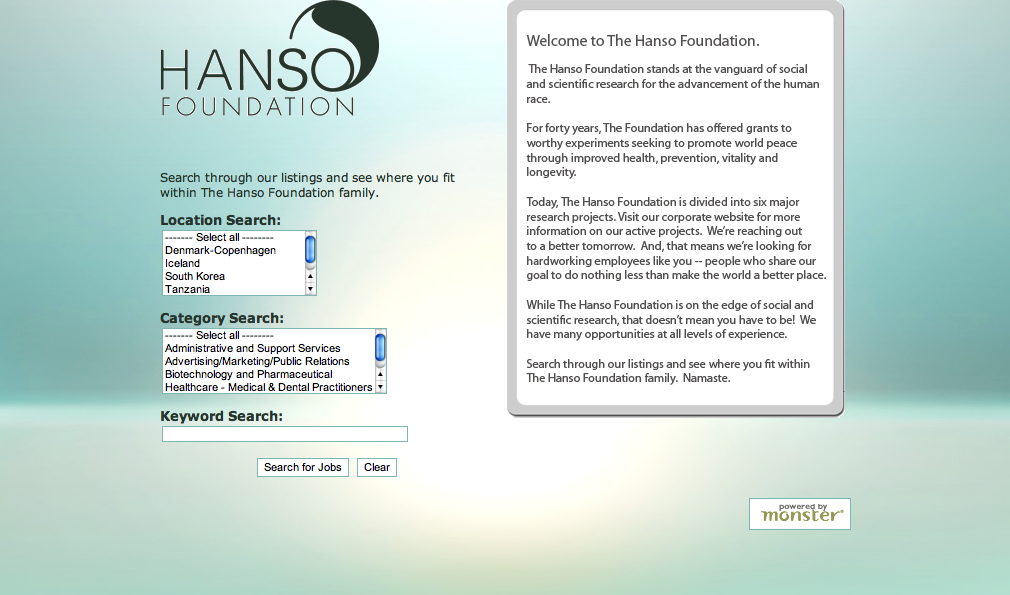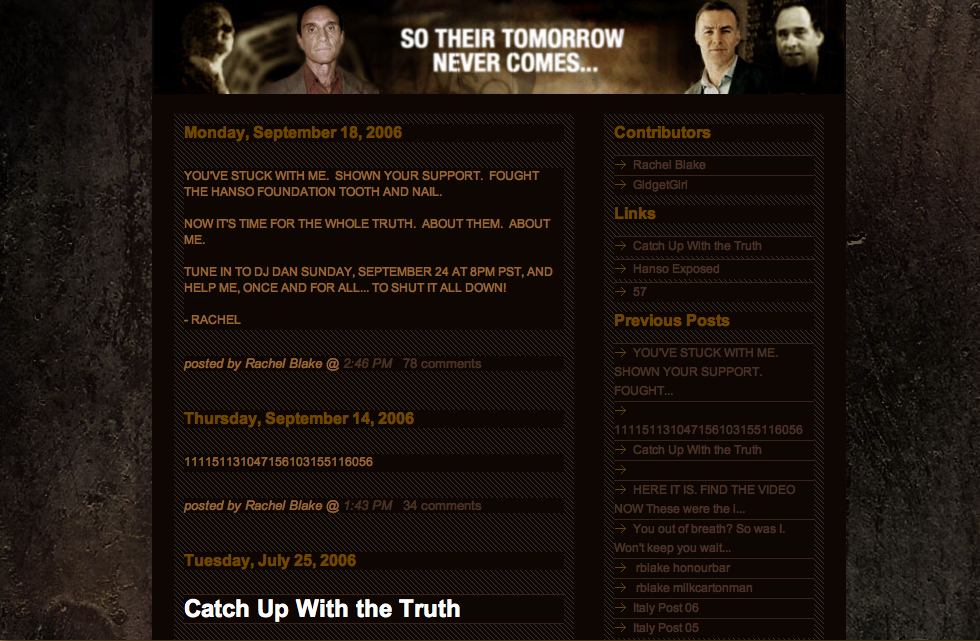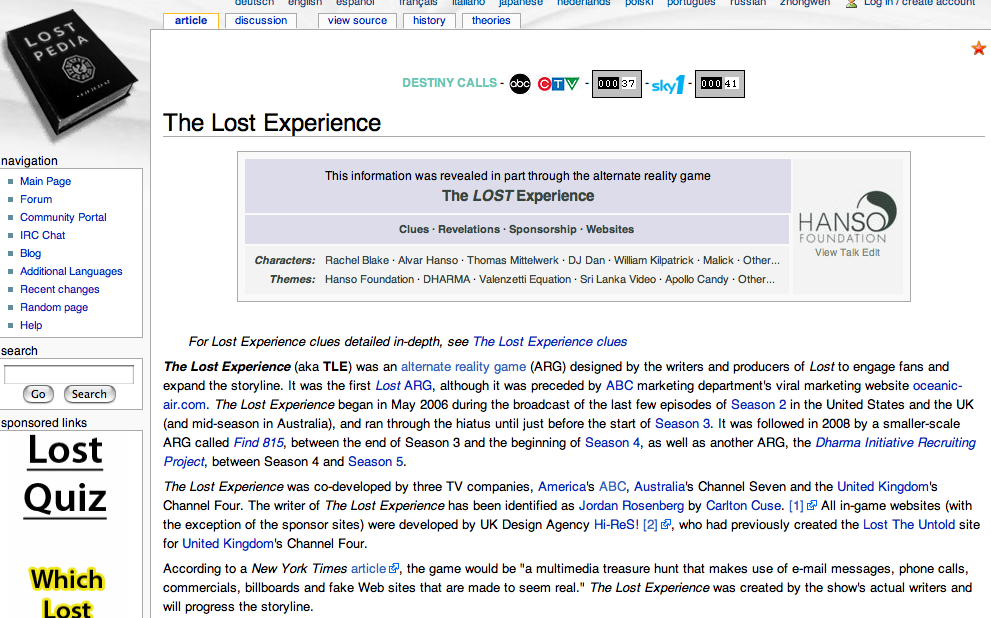Related Categories: Alternative Interfaces | Collective Reading
Summary:
Between seasons two and three of the television show Lost, ABC launched “The Lost Experience,” an Alternate Reality Game (ARG) designed to maintain viewer interest in the show. “The Lost Experience,” like many ARGs, incorporated a variety of media into its implementation. Players were encouraged to watch commercials that aired during the last episodes of season two in order to be notified of relevant websites that would provide clues to the game. In addition to websites, users watched mini-movies, read advertisements, and a tie-in novel. They were also directed towards recordings and podcasts over the course of “The Lost Experience.” While the game itself is a multi-media experience, this report will focus on the textual elements that played a crucial role in the game.
Description:
Introduced in May 2006, “The Lost Experience” began with a commercial for the Hanso Foundation, a fictional company within the show that, among other activities, helps fund the Dharma Initiative, another fictional company within the show. Though users worked together to amass clues and relevant information for the game, they identified primarily with the character of Rachel Blake (she is later discovered to be the daughter of Alvar Hanso) who seeks to expose the foundation’s activities.
As users followed the path of Rachel Blake, they were directed to websites like hansoexposed.com and whereisalvar.com in addition to her own blog, www.rachelblake.com, which includes the subdomain stophanso.rachelblake.com. While users were also encouraged to watch movie tie-ins and listen to recordings as part of the game, oftentimes transcripts of the recordings and descriptions of the mini-movies aided players in staying up-to-date without necessarily watching the movies or listening to the recordings.
Though the game provided advertising for companies like Jeep, Sprite, Verizon, and Monster.com, it was developed by the shows creators (not marketers) in order to provide an alternate method of exploring plotlines that they were not able to write into the actual show. The game focuses on The Hanso Foundation as well as the Widmore Corporation, which is affiliated with The Hanso Foundation.
Rachel Blake uncovers evidence against Thomas Mittelwerk, Alvar Hanso’s second in command at The Hanso Foundation. She discovers that Mittelwerk faked his credentials and is involved with illegal organ transplants and eventually kidnaps Alvar Hanso. Most disturbingly, Mittelwerk is involved in a plot to change the core values of the valenzetti equation (which presumably calculates the exact date humankind will cease to exist) by affecting the only factor he can change — the human population. Mittelwerk creates a virus that he administers under the pretext that it is a vaccine in order to reduce the population by thirty percent, thereby extending the date until humankind is extinguished. The game ends with the escape of Mittelwerk and the reinstatement of Alvar Hanso as the head of The Hanso Foundation.

A Fake Website for the Hanso Foundation
It should also be noted that The Valenzetti Equation is a fake book (it was never published, though in the mythology of the game Alvar Hanso bough all copies of the book as well as the rights to it) written by Gary Troup that details the particulars of the equation. Troup, another fictional character, allegedly wrote Bad Twin, a novel focused on the Widmore Corporation. In the novel, private detective Paul Artisan seeks to help Cliff Widmore find his twin brother Zander Widmore. Bad Twin was published by Hyperion Books in May 2006 and a manuscript of the book was featured in an episode of Lost. Sawyer read the manuscript, which apparently survived although the author, Gary Troup died during the plane crash of Oceanic Flight 815. Interestingly, the novel made it onto The New York Times bestsellers list. Prior to the publication of the novel, a fictional advertisement in The Washington Post, paid for by The Hanso Foundation, discouraged people from reading the book and complained about the novel’s portrayal of the foundation.
Research Context:
Though “The Lost Experience” is a multi-platform approach to narrative construction, it is interesting to note the reliance of the game on textual elements. Aside from texts like websites and Bad Twin, players are forced to rely on other players updating information on centralized sources of information like wikis and fan sites devoted to the game. ARGs in general (and “The Lost Experience” is not an exception) must also rely on news coverage for interested players to even be alerted that a game has begun. Though players also watch related movies and listen to relevant recordings, their main form of interaction with the game is textually mediated. They post for each other and track updates through websites that focus on user-generated material. Interestingly, one of the issues that arose from “”The Lost Experience” was that it was difficult to separate user-generated material from official “Lost Experience” material. This issue points to the way in which player collaboration manifested itself by having users become a part of the narrative itself.
Technical Analysis:
Because “The Lost Experience” utilizes a variety of media, there is not a set platform users must use in order to play the game. Information may be contained in an advertisement in a newspaper or in an online mini-movie. Generally speaking, users can benefit from high-speed internet access in order to not only access information online but to also collaborate with other players in terms of combining relevant information. Players should have computers with the capacity to read MP3s and support different media players since the media players vary depending on the website that sponsors them (for instance, one might have to use the Windows Media Player for one video and Quicktime for another)
Evaluation of Opportunities/Limitations for the Transliteracies Topic:
ARGs present a model for an alternate method of narrative formation. By taking a multi-media approach to storytelling, ARGs take advantage of media technologies in their implementation, allowing players to contribute to the narrative in ways that exceed the level of participation in terms of traditional game play. Whereas in a typical video game players follow a set number of pre-determined narrative paths, in ARGs, the blurring between player-created and producer-created websites and information highlight the ability of players to create new narrative paths. The proliferation of fan-based content also displaces the relationship between author and text by demonstrating the facility with which players become not only readers of ARGs, but also authors of them. The blurred relationship between author and text is further underscored by fan-generated material as the creators of the show (and the game) frequently implement fan feedback in the show.
Interestingly, users participating in the game often appear to mimic the role of Rachel Blake by updating information on wikis and posting to discussion forms to notify other players about relevant websites and other pieces of information. While most ARGs have a protagonist intended to guide players through the game, in the case of “The Lost Experience,” players often work with and identify with each other rather than solely relying on information provided by Rachel Blake.
“The Lost Experience” simultaneously allows players to participate in the narrative of the Lost world while also providing another venue for the creators to develop storylines that are not necessarily relevant to the rest of the show. By adding such a wealth of information and plot to the show, the creators are able to flesh out the characters and the fictional world they have created.
The game also highlights the need to archive material as many of the websites used during the game are no longer up. Since so many of the websites are down, not all of the mini-movies can even be watched. However, websites like lostpedia.com, dedicated to all things Lost, provides transcripts of recordings as well as stills from the mini-movies to help interested parties recreate the experience after the game’s completion. This fact points to the ephemeral nature of digital content and the need to create ways to archive digital information continually and in a variety of formats in order for the content to last. The responsibility of archiving rests largely with players and fans of the show as evidenced by the abandonment of the material by both the game’s creators and sponsors.
ARGs like “The Lost Experience” call attention to ubiquitous computing by demonstrating the way in which people unaffiliated with the game become its unwilling participants. For a person who sees The Washington Post advertisement or decides to read Bad Twin for no other reason than the fact that it is on The New York Times Bestsellers List, they do not know these pieces of information are part of “The Lost Experience,” but they become a part of it anyway. Another such example of people unknowingly participating in the game can be seen in the website sublymonal.com. Sublymonal.com was one of the Sprite-sponsored websites for the game. The sublymonal advertising campaign has continued after the end of “The Lost Experience,” encouraging viewers to visit a website that was originally part of an ARG.
ARGs illustrate one way in which a variety of media can be employed to not only create a narrative, but also solve problems through collaboration. Some ARGs have even tackled real-world issues. An area of further study would be to see how ARGs on a perhaps smaller scale could be utilized to solve issues on not just a national or global scale, but perhaps a local scale as well.
Resources for Further Study:
Recent ARGs:
The Lost Experience Links:


